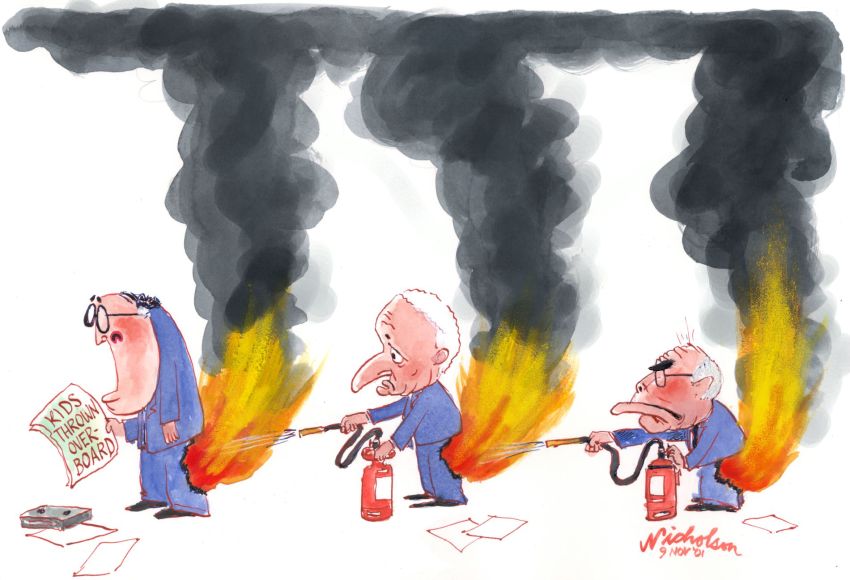Earlier I wrote of how some opinion columnists take advantage of looser fact-checking rules of the editorial pages to come up with their own facts, either misleading or outright wrong, to give their opinions more weight. I thought it might be useful to provide some actual examples of what I mean.
The first two both come from articles taking Liberal Party
leader Justin Trudeau to task for some ill-advised comments about green energy
in China, which then went on to denigrate renewable energy programs in other
countries.
One national columnist stated that China’s solar industry is
“collapsing”, and cited the case of a single failed company to prove it. The other went off on a wider tangent about German coal, speaking of an “explosive
resurgence” of coal-electricity leading to “skyrocketing” emissions.
What really happened in China was that too many companies
sprang up to take advantage of high profits from generous subsidies aimed at jump-starting the
solar industry. This created an oversupply of panels, leading prices to drop,
and now many of those companies will fold. But that doesn’t mean the industry
as a whole is going down the tubes - just that the weakest companies are being
weeded out. Demand for new solar, in China and worldwide, remains strong, so
companies that survive the shakeout will still have a market to thrive in.
China will continue to lead the world’s growing solar industry for some time to
come. To paint the failure of one company or a temporary supply-demand mismatch
as the decline of an entire industry isn’t an opinion, it’s either ignorance or
deliberate misrepresentation.
In the wake of the ongoing Fukushima disaster, Germany has
turned away from nuclear power. It’s true that Germany’s use of coal to produce
electricity has increased somewhat over the past few years, in particular going
from around 161 billion tonnes lignite burned in 2012 to 162 billion in 2013!
Skyrocketing? Exploding? Hardly. And this small increase over the past few
years, from a low of 140 billion tonnes, is not primarily due to nuclear
shut-downs, but a fuel switch because of rising prices for natural gas. The
reduction in burning expensive natural gas has been much larger than the
reduction of nuclear power, and far more than the increase in use of cheaper coal.
Meanwhile, the much-derided German renewable energy market continues to expand
in capacity and reliability, providing a decent replacement for lost nuclear.
The third example comes from a local columnist who boldly asserted that wind farms were creating rampant ghost towns in rural Ontario.
Now, he is undoubtedly correct that parts of rural Ontario are depopulating,
which makes it harder for each next person leaving to sell their home. But
there is no evidence that this loss of property value or population has
anything to do with wind energy. It’s been a long-term trend that I’ve observed
all my life. Growing up in Shelburne, which was within 60-90 minutes of the
GTA, I saw how rural communities to the south and east kept growing in population and
prices, while those to the north and west shrank. This was long before anyone dreamed
that farmland could gain a second use by generating valuable wind power. Quite simply, rural living near urban jobs
& amenities is prized, while rural living far from the bright city lights is
a faint attraction. As people leave, local tax revenues drop, schools close,
banks and other businesses leave, and the downward spiral continues. Wind farms
actually counteract this trend, by putting more money into local pockets and
bringing in good trades jobs for construction & maintenance.
When we look at the effect of wind power on property values, there
are anecdotal accounts or unrepresentative case studies that show harm, but the
major well-designed studies show there is little or no downward effect on land
values as wind development arrives. As for the writer’s evidence, he didn’t
provide any, and after it was pointed out to him that the population of his
example “ghost town” was actually growing, admitted that all he’d done was talk
to some friends and look at the info from some anti-wind organizations. All the
real evidence shows that the decline in rural populations is a long-term trend
related mainly to the loss of factory jobs and service cutbacks by
cash-strapped municipalities and school boards, not wind farms. Even anti-wind
sites acknowledge this chain of events.
Of course, there is nothing wrong with disagreeing with what a
political party leader says or how a government acts, or presenting challenges
with renewable energy, or supporting traditional alternatives like coal or
nuclear, but backing those opinions with statements of fact that don’t actually
state the facts is poor writing, at best. Either they haven’t bothered to do
the basic research or don’t want to tell the truth. When you read something in
the paper that’s presented as fact, you should be able to trust that it is
indeed the fact, without having to do your own research only to find that
wasn’t true.
But I’ll let you decide. Is making up facts to back opinions
deliberately misleading, or merely lazy?
A shorter version of this was published as my Root Issues column in the Barrie Examiner under the title "Making up facts to back opinions deliberately misleading".Erich Jacoby-Hawkins is a director of Living Green and the Robert Schalkenbach Foundation.

Thanks for sharing this blog this is very useful to me
ReplyDeleteRenewable energy solutions